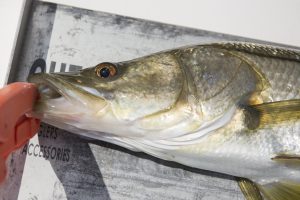Written by Jordan Bajema, Ph.D. Student, School of Natural Resources and Environment. Advisor: Will Patterson.

Anglers along the Nature Coast may have noticed a new species in town the last few years, the Common Snook. This iconic Florida sportfish has certainly made its presence known in the region over the last decade and has provided countless hours of entertainment to local anglers. The first Snook documented by researchers in the region was caught in 2000, but Snook did not appear in large numbers until the most recent decade. Historically Snook were found south of Tarpon Springs, but today they can be found north of the Suwannee River Estuary. It is thought the range of this species is expanding northward because of warming winter temperatures. However, it is important to note that the arrival of a new species can bring changes to the ecosystems and fisheries of an area.
Our research in this area is part of a partnership that includes support from:
- The Florida Fish and Wildlife Conservation Commission
- The University of Florida
- Z-man Fishing Products, Inc.
- Suwannee River Water Management District
- Southwest Florida Water Management District
Together, the team seeks to understand what these changes may be, if there is competition with other popular species (Red Drum and Spotted Seatrout), and if this new population is here to stay.

Are Snook a subtropical/tropical species?
Snook cannot withstand winter water temperatures below about 50o F. Therefore, while the warmer winter temperatures have allowed them to expand into the area, it still gets cold enough in the region to pose a problem to these prized fish. We have all heard stories of mass fish kills during cold snaps, and the Snook in this region could be especially susceptible to this phenomenon. Our team has developed a fish tracking study, using acoustic telemetry, to try to better understand the behaviors of Snook during these events and discover how they are persisting in the region. We hypothesize that some of these fish are using spring discharge to stay warm during these cold events. However, preliminary analysis shows that not all Snook are utilizing these spring runs and there may be a variety of survival strategies. Our tracking work will allow us to better understand how Snook are surviving the cold temperatures in the region and in turn, will allow us to recommend management strategies that will ensure their persistence in the region and protect the ongoing recreational opportunities provided by them.

Impacts of Snook on other species?
Some anglers have expressed concern over what Snook in the region are eating and whether it is affecting other popular sportfish, such as Red Drum and Spotted Seatrout. Anglers frequently catch all three of the species on the same day in the same area with the same bait, so they clearly overlap in habitat and food habits. We have developed a multifaceted study to address this concern. Hundreds of stomachs have been collected from Snook, Red Drum, and Spotted Seatrout, and we are visually analyzing the contents of these stomachs to start creating a broader picture of what these different species are eating and if they are directly competing for food. Unfortunately, some of the prey items are partially digested, and we cannot always identify them. These unidentifiable items are being analyzed using DNA techniques to overcome this identification hurdle. However, stomach content analysis only provides a snapshot of what the fish ate over the last day or two. It is also important to learn how the fish eat over a longer time scale. Luckily, you are what you eat, and your diet is reflected in your body tissues. Each fish that was sampled for stomach content was also sampled for muscle tissue. The chemicals contained in muscle tissues can provide us with information on what kind of prey items the fish have been consuming in the months leading up to their capture. Combining stomach contents, DNA, and muscle tissue chemical signatures will allow us to identify whether Snook, Red Drum, and Spotted Seatrout are eating the same things or even if they are eating each other.
Through a combination of these studies, we will be able to better estimate the movement and potential impact of Snook in the Nature Coast region of Florida. This will allow for the proper management of Snook and the other economically important species in the region. The research will also allow us to add to our understanding of the ecosystem dynamics in the Nature Coast region and will help us better understand and predict the impacts of future range expansions by other species. We are immensely grateful to all of our partners, as it is rare to have a private fishing company (Z-man Fishing Products) combined with a range of public agencies to address these emerging challenges in fisheries management.
 2
2
